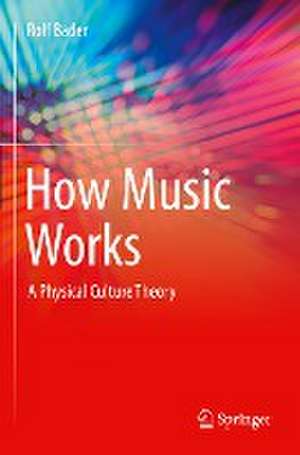How Music Works: A Physical Culture Theory
Autor Rolf Baderen Limba Engleză Paperback – 8 apr 2022
| Toate formatele și edițiile | Preț | Express |
|---|---|---|
| Paperback (1) | 274.64 lei 3-5 săpt. | +70.21 lei 4-10 zile |
| Springer International Publishing – 8 apr 2022 | 274.64 lei 3-5 săpt. | +70.21 lei 4-10 zile |
| Hardback (1) | 308.76 lei 3-5 săpt. | |
| Springer International Publishing – 8 apr 2021 | 308.76 lei 3-5 săpt. |
Preț: 274.64 lei
Nou
Puncte Express: 412
Preț estimativ în valută:
52.56€ • 54.89$ • 43.58£
52.56€ • 54.89$ • 43.58£
Carte disponibilă
Livrare economică 21 ianuarie-04 februarie 25
Livrare express 04-10 ianuarie 25 pentru 80.20 lei
Preluare comenzi: 021 569.72.76
Specificații
ISBN-13: 9783030671570
ISBN-10: 3030671577
Pagini: 287
Ilustrații: XVIII, 287 p. 21 illus., 12 illus. in color.
Dimensiuni: 155 x 235 x 21 mm
Greutate: 0.44 kg
Ediția:1st ed. 2021
Editura: Springer International Publishing
Colecția Springer
Locul publicării:Cham, Switzerland
ISBN-10: 3030671577
Pagini: 287
Ilustrații: XVIII, 287 p. 21 illus., 12 illus. in color.
Dimensiuni: 155 x 235 x 21 mm
Greutate: 0.44 kg
Ediția:1st ed. 2021
Editura: Springer International Publishing
Colecția Springer
Locul publicării:Cham, Switzerland
Cuprins
Some Fundamentals of Musical Acoustics.- Some Fundamentals of Music Psychology.- Some Fundamentals of Comparative Musicology.- Impulses.- Turbulence.- Saxophone.- More wind instruments.- Friction Instruments.- Guitars and Plucked String Instruments.- The Human Voice.- Neurophysiology of Music.- Music and Consciousness.- Reconstructing Impulses - The Ear and the Auditory Pathway.- Timbre.- Rhythm, Musical Form, and Memory.- Music, Meaning, and Emotion.- Physical Culture Theory.
Notă biografică
Rolf Bader is a professor for Systematic Musicology, which he studied in Hamburg, Germany, together with Physics, Ethnology, and Historical Musicology. After teaching at Stanford University as a Visiting Scholar, he teaches at the Institute of Systematic Musicology at the University of Hamburg since 2007. His main research interests are Physical Modeling of Musical Instruments, Timbre and Rhythm Perception, Musical Signal Processing, Room Acoustics, or Music Ethnology. He also works on Self-organization and Synergetics of Musical Instruments and Music Perception. He is the editor of the Springer Handbook of Systematic Musicology, and wrote monographs like Computational Mechanics of the Classical Guitar or Nonlinearities and Synchronization in Musical Acoustics and Music Psychology, and edited volumes like Sound-Perception-Performance or Computational Phonogram Archiving in the Springer Series Current Research in Systematic Musicology, where healso is an editor-in-chief. He works as an Ethnomusicologist, mainly in Myanmar, Cambodia, China, India, or Sri Lanka. He is also a musician and composer in the fields of free improvised and electronic music, as well as Fusion and Rock, and published several CDs.
Textul de pe ultima copertă
How do we understand culture and shape its future? How do we cross the bridge between culture as ideas and feelings and physical, cultural objects, all this within the endless variety and complexity of modern and traditional societies? This book proposes a Physical Culture Theory, taking culture as a self-organizing impulse pattern of electric forces. Bridging the gap to consciousness, the Physical Culture Theory proposes that consciousness content, what we think, hear, feel, or see is also just this: spatio-temporal electric fields. Music is a perfect candidate to elaborate on such a Physical Culture Theory. Music is all three, musical instrument acoustics, music psychology, and music ethnology. They emerge into living musical systems like all life is self-organization. Therefore the Physical Culture Theory knows no split between nature and nurture, hard and soft sciences, brains and musical instruments. It formulates mathematically complex systems as Physical Models ratherthan Artificial Intelligence. It includes ethical rules for maintaining life and finds culture and arts to be Human Rights. Enlarging these ideas and mathematical methods into all fields of culture, ecology, economy, or the like will be the task for the next decades to come.
Caracteristici
Presents a physical culture theory of music for everyone This intriguing popular science book suggests a basic mechanism how music works: self-organization or synchronization Sometimes I hear people saying that knowing how music works destroys the magic in music. After decades of doing research in systematic musicology and as a professional musician I find that the opposite is true”
